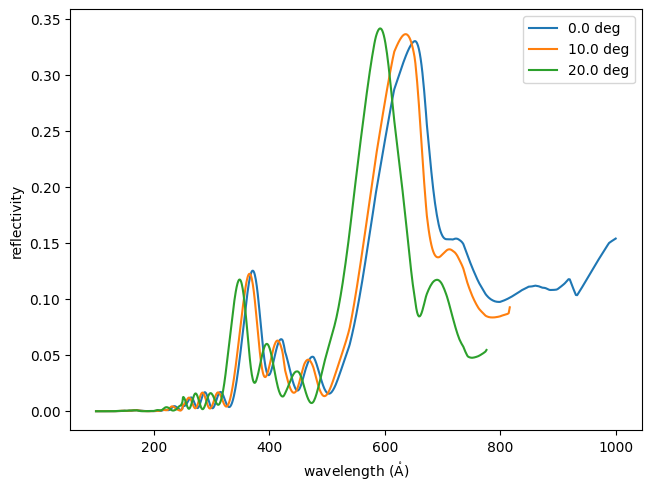multilayer_fit#
- esis.flights.f1.optics.gratings.materials.multilayer_fit()#
A multilayer coating determined by modifying
multilayer_witness_fit()to have a glass substrate with the appropriate roughness.Examples
Plot the theoretical reflectivity of this multilayer stack vs. the theoretical reflectivity of
multilayer_witness_fit().import numpy as np import matplotlib.pyplot as plt import astropy.units as u import named_arrays as na import optika from esis.flights.f1.optics import gratings # Define a grid of wavelength samples wavelength = na.geomspace(100, 1000, axis="wavelength", num=1001) * u.AA # Define a grid of incidence angles angle = 4 * u.deg # Define the light rays incident on the multilayer stack rays = optika.rays.RayVectorArray( wavelength=wavelength, direction=na.Cartesian3dVectorArray( x=np.sin(angle), y=0, z=np.cos(angle), ), ) # Initialize the multilayer stacks multilayer_witness_fit = gratings.materials.multilayer_witness_fit() multilayer_fit = gratings.materials.multilayer_fit() # Define the vector normal to the multilayer stack normal = na.Cartesian3dVectorArray(0, 0, -1) # Compute the reflectivity of the multilayer for the given incident rays reflectivity_witness = multilayer_witness_fit.efficiency(rays, normal) reflectivity_fit = multilayer_fit.efficiency(rays, normal) # Plot the reflectivities as a function of wavelength fig, ax = plt.subplots(constrained_layout=True) na.plt.plot( wavelength, reflectivity_witness, ax=ax, axis="wavelength", label="witness fit", ); na.plt.plot( wavelength, reflectivity_fit, ax=ax, axis="wavelength", label="grating fit", ); ax.set_xlabel(f"wavelength ({wavelength.unit:latex_inline})"); ax.set_ylabel("reflectivity"); ax.legend();

Plot the reflectivity of this multilayer stack as a function of incidence angle.
import numpy as np import matplotlib.pyplot as plt import astropy.units as u import named_arrays as na import optika from esis.flights.f1.optics import gratings # Define a grid of wavelength samples wavelength = na.geomspace(100, 1000, axis="wavelength", num=1001) * u.AA # Define a grid of incidence angles angle = na.linspace(0, 20, axis="angle", num=3) * u.deg # Define the light rays incident on the multilayer stack rays = optika.rays.RayVectorArray( wavelength=wavelength, direction=na.Cartesian3dVectorArray( x=np.sin(angle), y=0, z=np.cos(angle), ), ) # Initialize the multilayer stack multilayer = gratings.materials.multilayer_fit() # Compute the reflectivity of the multilayer for the given incident rays reflectivity = multilayer.efficiency( rays=rays, normal=na.Cartesian3dVectorArray(0, 0, -1), ) # Plot the reflectivity of the multilayer as a function of wavelength fig, ax = plt.subplots(constrained_layout=True) na.plt.plot( wavelength, reflectivity, ax=ax, axis="wavelength", label=angle, ); ax.set_xlabel(f"wavelength ({wavelength.unit:latex_inline})"); ax.set_ylabel("reflectivity"); ax.legend();

- Return type:

